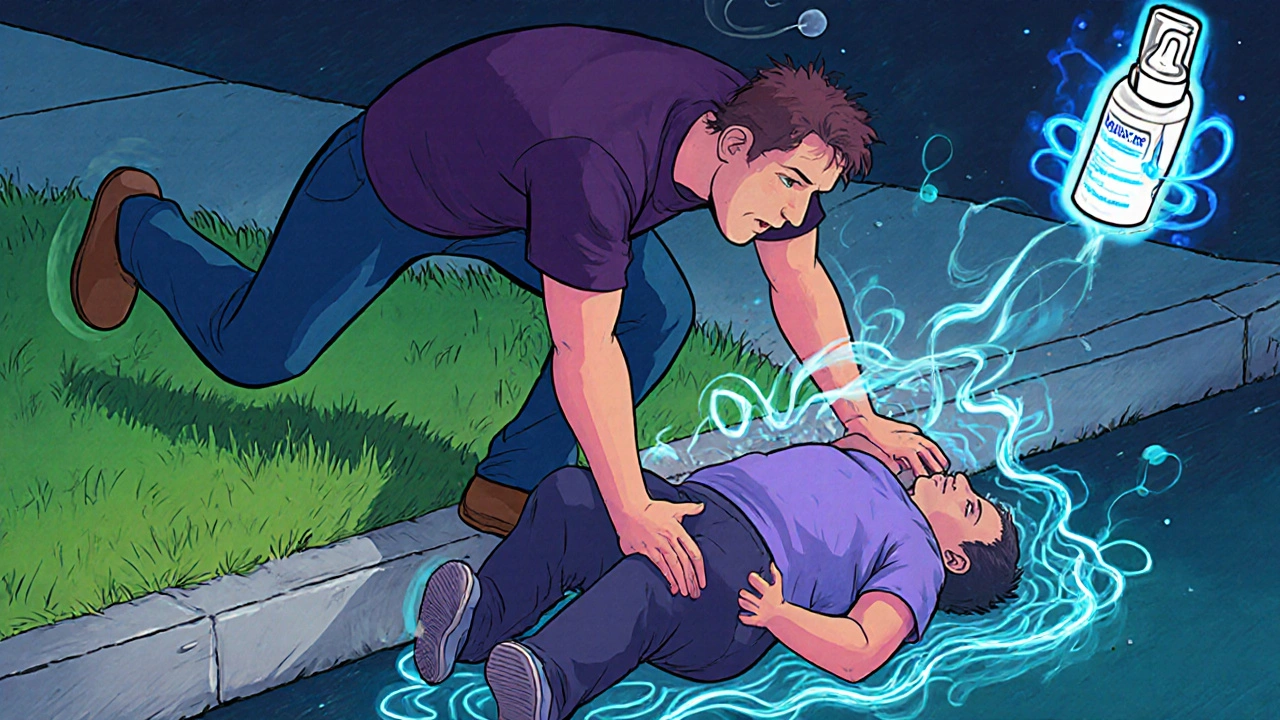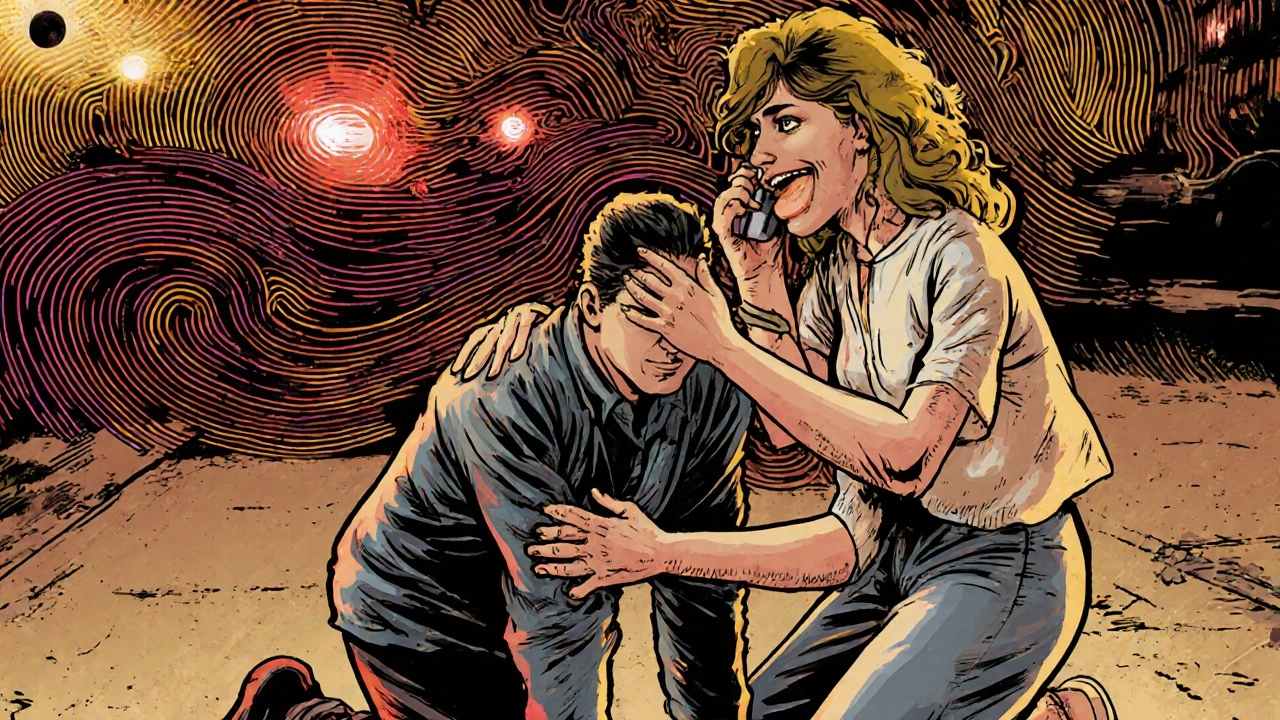What to Do When Someone Might Be Overdosing
If you suspect someone is overdosing, time is the most critical factor. Every second counts. The brain starts to suffer damage after just 4 to 6 minutes without oxygen. Many people freeze in these moments-waiting to see if the person wakes up, hoping it’s just deep sleep, or fearing legal trouble. But here’s the truth: acting fast can save a life. You don’t need to be a doctor. You don’t need to know every drug involved. You just need to know the steps.
Step 1: Check Responsiveness and Call for Help
Shake the person’s shoulder and shout their name. Don’t use the old “shake and shout” method blindly-it delays action. If they don’t respond, immediately call emergency services. In Australia, dial 000. Say clearly: “I think someone is overdosing.” Don’t wait to see if naloxone works. Don’t wait to find your phone. Call first. EMS arrival reduces death risk by 35%, according to JAMA. While you’re on the phone, keep talking. The dispatcher can guide you through the next steps.
Step 2: Check Breathing and Airway
Look, listen, and feel for breathing. Don’t assume they’re just sleeping. Overdose can look like deep sleep-slowed, irregular, or shallow breaths. Gasping or snoring sounds are signs of trouble, not recovery. If they’re not breathing normally, open their airway. Tilt their head back gently and lift their chin. This moves the tongue away from the back of the throat. Don’t insert your fingers into their mouth. That can push debris further in or cause injury.
Step 3: Start Rescue Breathing
If they’re not breathing or only gasping, begin rescue breathing right away. Pinch their nose shut. Cover their mouth with yours, making a tight seal. Give one breath every 5 to 6 seconds-about 10 to 12 breaths per minute. Each breath should last about 1 second and make their chest rise. Don’t blow too hard. If you see their stomach puff up, you’re blowing too much air. That increases the risk of vomiting and choking. Keep going. Even if you’re tired, don’t stop until help arrives or they start breathing on their own. Most overdoses are caused by opioids, and rescue breathing alone can keep someone alive long enough for naloxone or EMS to arrive.

Step 4: Use Naloxone If Available (and Only for Opioids)
Naloxone reverses opioid overdoses. It won’t work on alcohol, benzodiazepines, or stimulants like cocaine or meth. If you have it, use it. Most naloxone kits today are nasal sprays. Lay the person flat on their back. Tilt their head back slightly. Insert the nozzle into one nostril. Press the plunger firmly for 2 to 3 seconds. You don’t need to switch nostrils unless they don’t respond after 3 minutes. Naloxone can wear off faster than the drug they took. Even if they wake up, they still need medical help. The drug could come back and shut their breathing down again.
Step 5: Place Them in the Recovery Position
If they’re breathing but still unconscious, roll them onto their left side. This is the recovery position. It keeps their airway open and prevents choking if they vomit. Here’s how: Kneel beside them. Straighten their legs. Bend their far leg at the knee. Place their far arm under their head. Gently roll them toward you, keeping their head, neck, and spine aligned. Their top leg should be bent at 90 degrees to stabilize them. Their head should be tilted slightly back. Check their breathing every 2 to 3 minutes. Don’t leave them alone.
What Not to Do
Don’t put them in a cold shower or ice bath. That’s a myth. Cold shock can trigger dangerous heart rhythms, especially with stimulant overdoses. Don’t try to make them walk or “sober up” with coffee or food. That won’t help and could cause falls or choking. Don’t wait to see if they “get better.” Overdose doesn’t fix itself. Don’t assume they’re fine because their pupils aren’t pinpoint. Fentanyl overdoses often don’t show classic pinpoint pupils. Don’t assume naloxone is a cure-all. It’s a bridge to medical care-not the finish line.

Different Drugs, Different Risks
Not all overdoses are the same. Opioids like heroin, fentanyl, or prescription painkillers slow or stop breathing. That’s why rescue breathing and naloxone are life-saving. Stimulants like meth or MDMA cause overheating, high blood pressure, and heart strain. For these, keep the person cool. Remove excess clothing. Fan them. Apply cool, damp cloths to their neck, armpits, and groin. Don’t use ice packs directly on skin. Alcohol overdoses can cause vomiting and aspiration. Keep their head turned to the side. Never leave an unconscious person alone, even if they’ve been drinking.
Why Training Matters
People who’ve been trained respond faster and more accurately. A 2023 study found trained bystanders positioned someone correctly in under a minute. Untrained people took over 3 minutes. That delay can be fatal. Training also helps you recognize signs you might miss-like irregular breathing, blue lips, or unresponsiveness. Communities with widespread naloxone access and training have reversed over 12,500 overdoses with a 98.7% survival rate to hospital discharge. You don’t need a certification to help. But if you’re around people who use drugs-whether a friend, family member, or stranger-take 30 minutes to learn. Many free online courses exist, including ones from the Australian Drug Foundation and the CDC.
What Comes After
Even if the person wakes up, they still need to go to the hospital. Naloxone wears off in 30 to 90 minutes. The drug in their system might not. They could slip back into overdose. Emergency staff can monitor them, give fluids, treat complications, and connect them with support services. If they’re willing, ask if they want help finding treatment. Don’t lecture. Just say: “I’m here if you want to talk.” Many people overdose because they’re isolated, afraid, or in pain. Your actions might be the first step toward recovery.
Final Thought: You Are the First Responder
You don’t need to be brave. You just need to act. Every year, thousands die because someone waited too long. You can change that. Call 000. Check breathing. Give breaths. Use naloxone if you have it. Roll them into position. Stay with them. You’re not responsible for their choices. But you are responsible for what you do next. And that matters more than you know.
Can naloxone harm someone who didn’t overdose?
No. Naloxone only works on opioids. If someone hasn’t taken opioids, naloxone will have no effect. It’s safe to use even if you’re unsure. There’s no risk of overdose from naloxone itself. If you suspect an opioid overdose, give it. Better safe than sorry.
What if I’m scared to call emergency services?
It’s normal to fear legal trouble, but Australia has Good Samaritan laws that protect people who call for help during an overdose. You won’t be arrested for possession if you’re seeking help for someone else. EMS responders are there to save lives, not punish. Your call could be the reason someone lives to see tomorrow.
How do I know if someone is really overdosing and not just asleep?
Try to wake them. If they don’t respond to loud shouting or shoulder shaking, assume it’s an overdose. Look for signs: slow or irregular breathing, blue or gray lips/fingertips, limp body, unresponsiveness, or snoring/gurgling sounds. Sleep doesn’t cause these symptoms. If you’re unsure, treat it like an overdose. Waiting could cost their life.
Can I give naloxone to a child or teenager?
Yes. Naloxone is safe for all ages, including children and teens. There’s no lower age limit. The dose is the same regardless of size. If a young person has overdosed on opioids, naloxone can reverse it just as effectively as in adults. Don’t hesitate because of their age.
What if I don’t have naloxone?
You can still save a life. Rescue breathing alone is often enough to keep someone alive until EMS arrives. Many people survive opioid overdoses because bystanders kept breathing for them. Don’t wait for naloxone. Start rescue breathing immediately. Call 000. Stay with them. Your actions matter more than the tools you have.
How long should I keep giving rescue breaths?
Keep going until they start breathing normally on their own, or until emergency help arrives. Don’t stop after a few minutes just because you’re tired or think they’re improving. It’s common for people to wake up briefly, then slip back into overdose. Continue rescue breathing for as long as needed. Even 10 minutes of breaths can make the difference between life and death.

